What Psi Do You Use To Clean A Wood Deck
How to Force per unit area Launder a Deck
Bring new life to your crumbling deck for less than $300.
![]() Fourth dimension
Fourth dimension
A full twenty-four hours
![]() Complexity
Complexity
Beginner
![]() Price
Price
$101–250
Introduction
Deck seen too many summers? Requite information technology a new lease on life for less than $300. We'll testify you how to clean and renew your deck like a pro in two four-hour periods.
Tools Required
Materials Required
- Deck stain
- Oxalyc Acid
Overview
If yous've been putting off renewing your deck because you think it requires a lot of fourth dimension, tools and know-how, accept heart. In this article, we'll show y'all how to clean it up fast with the help of a pressure washer and special products that aid remove clay, mildew and quondam finishes. We'll also show you how to apply a fresh finish, using a foam applicator pad that glides forth the wood and apace applies a overnice, even coat. No more messy rollers and brushes.
This procedure will work on whatsoever wood deck, including redwood, cedar and pressure treated lumber (only not on blended decks). The only special tools you need are a pressure washer and a foam applicator pad. The project doesn't crave whatever special skills. Simply set bated at least 4 hours on 1 day to clean your deck, and some other four hours several days later on to stain it.
The toll of rejuvenating an boilerplate-size deck is about $250, including tools, materials and the pressure washer rental. You'll save several hundred dollars by doing the work yourself. Having your deck professionally cleaned and stained will toll $500 to $one,000.
Rent a pressure washer
A pressure washer will scour away dirt and contaminants ingrained in the wood at the same time information technology sprays on a deck stripper to clean off previous finishes.
Rent a pressure washer deck cleaner from a home eye or rental center (most $40 for four hours, or $seventy per 24-hour interval). A pressure level setting of i,000 to i,200 psi is platonic. Likewise much pressure will damage the wood and brand the wand harder to control.
Rent a unit that allows for the intake of chemical cleaners (deck stripper and forest brightener) so y'all tin spray them on through the wand. Nigh force per unit area washers take an intake hose that draws in cleaners from a separate bucket. (Use a plastic bucket. Chemicals in the cleaners tin react to metallic buckets.)
We used sodium hydroxide as the deck stripper. You probably won't exist able to find straight sodium hydroxide, but you tin can detect a deck stripping production with sodium hydroxide every bit the active ingredient in about any home centre or paint store.
We diluted our stripper to a 50/l mix with water. Some sodium hydroxide–based strippers are premixed and don't require calculation h2o. More commonly, yous need to dilute the stripper with water. Read the characterization on the container to observe out what's suggested for your stripper.
Protect your house and plants
Before yous brainstorm cleaning, make repairs to your deck, such as replacing cracked or split boards and broken balusters.
Then heavily douse the plants or grass nether and around your deck with h2o and embrace them with plastic. Although about strippers aren't supposed to harm vegetation, it'due south still a good idea to protect plants and it only takes a few minutes. Once yous've finished cleaning the deck, immediately remove the plastic.
Also spray down the siding with clean water to ensure that any stripper that splashes onto the house will easily wash off.
Project step-by-step (11)
Step 1
Scour away the old finish
Clean the railings
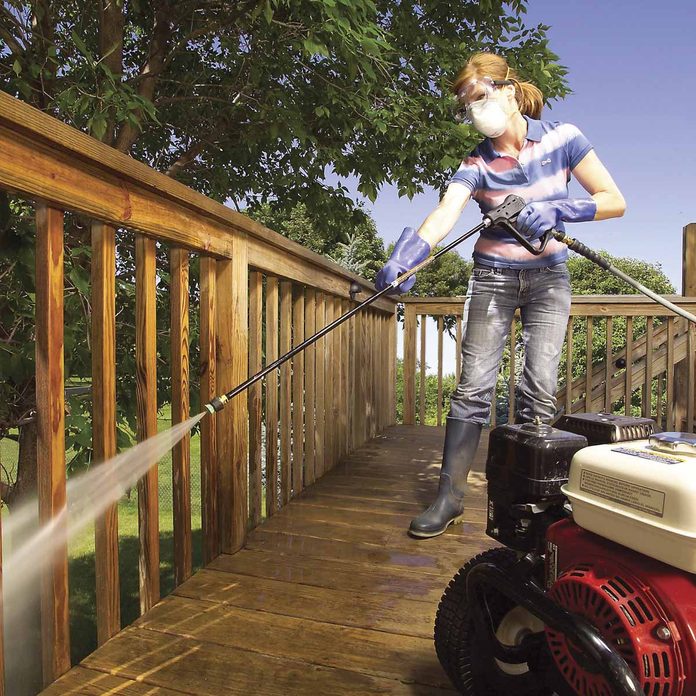
Force per unit area-wash the railings with stripper. Keep the tip half-dozen to x in. from the wood and work from the pinnacle down. Spray balusters at the corners to scour two sides at in one case.
Step 2
Wash the decking
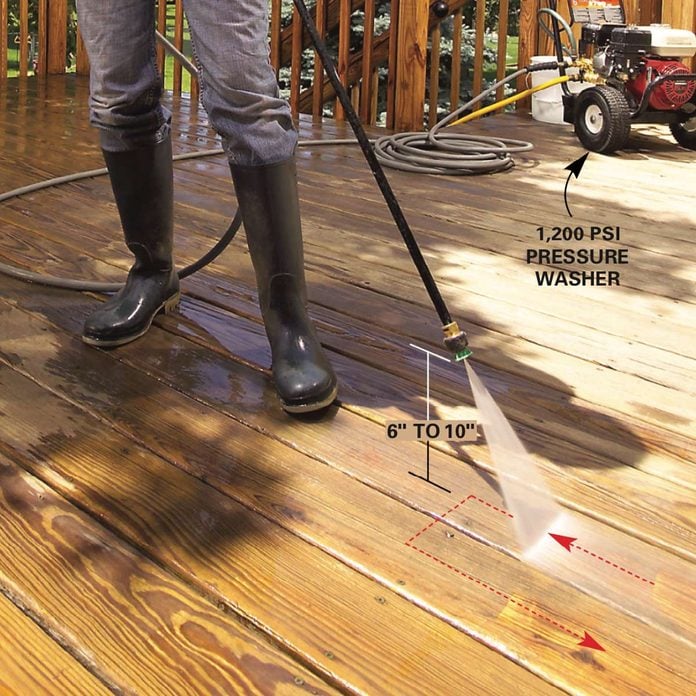
Spray one deck board at a fourth dimension, using a gentle sweeping motion. Avert sudden stops. Work from the stop of the deck toward the exit. Then rinse the entire deck with a garden hose.
Step 3
Clean out the gaps between decking
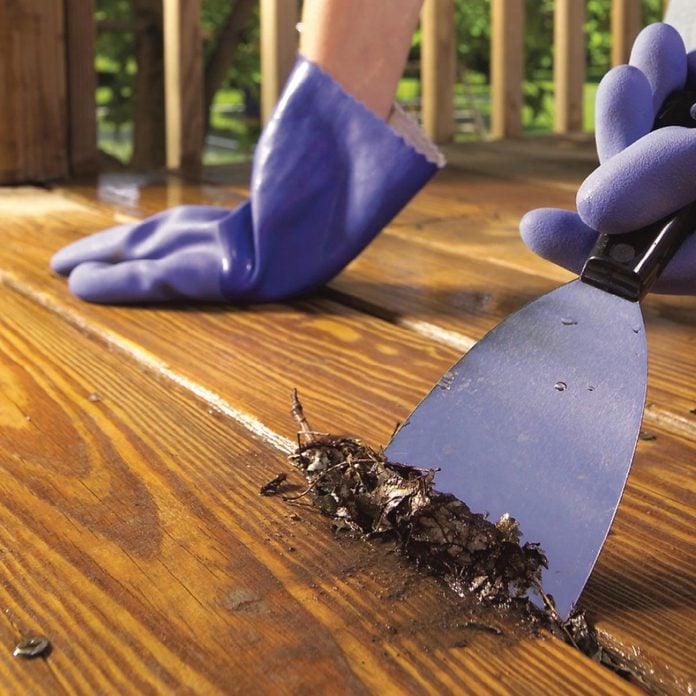
Dig out trapped debris from between deck boards with a putty knife. Spray the deck lightly with a mixture of oxalic acid and h2o to burnish the wood.
With a 25- or 30-caste tip in the wand of the force per unit area washer and a psi of 1,000 to 1,200, apply the stripper to the deck, starting with the height rail and working down the balusters (Photo one). Spray the rails with a continuous, controlled motion. Keep the wand moving so y'all don't gouge the woods.
Once you finish the railings, start on the deck boards. Wash along the length of the boards (Photo 2). You'll see the crud washing off the woods.
Go over stubborn mildew or other stains a few times rather than turning up the pressure level or trying to heavily scour the forest. Afterward we'll tackle tough stains that won't come out with the stripper.
This stripping process washes away a small amount of the wood'southward lignin, which is the glue holding the wood fibers together. As the lignin washes away, the fibers stand up, giving the forest a fuzzy advent. Don't carp sanding off the fuzzy fibers. They volition gradually shear off and blow away.
After you've power-washed the entire deck, rinse all of the wood with plain water to dilute and neutralize the stripper. If at that place's notwithstanding debris trapped betwixt deck boards, such as leaves or twigs, remove it now (Photo 3).
Step 4
Brighten the wood
Clean off overspray

Rinse the siding and windows with clean h2o at low pressure level to remove chemical residue.
A deck brightener volition return the wood to its newly sawn colour and arrive more receptive to the stain. Use an oxalic acrid–based brightener, which is available at home centers and paint stores. It works fast, won't harm the woods and is environmentally safety in the diluted solution that yous'll utilise.
Similar strippers, some deck brighteners come premixed and some need to exist diluted with water. Read the characterization for the manufacturer's recommendations. We mixed our oxalic acid with an equal amount of water and ran information technology through the pressure washer's intake hose.
Change the tip in the wand of the pressure washer to a fan tip with a xl- or 45-degree bending. Then set the pressure to about i,000 psi and spray the deck, once over again starting with the top rails and working down to the deck boards. Apply just enough brightener to thoroughly wet the wood.
Oxalic acid will burnish the wood in a matter of minutes and does not require rinsing. Only your siding does. Rinse off your siding with clean water at very depression pressure (about 500 psi) to wash abroad any stripper or brightener overspray (Photo 4).
If your woods is cedar or redwood, you'll see a dramatic difference as the woods brightens to its fresh sawn color. Our deck is pressure level-treated pino, and so the brightening of the wood is less noticeable.
Pace five
Inspect the whole deck
Fix loose boards
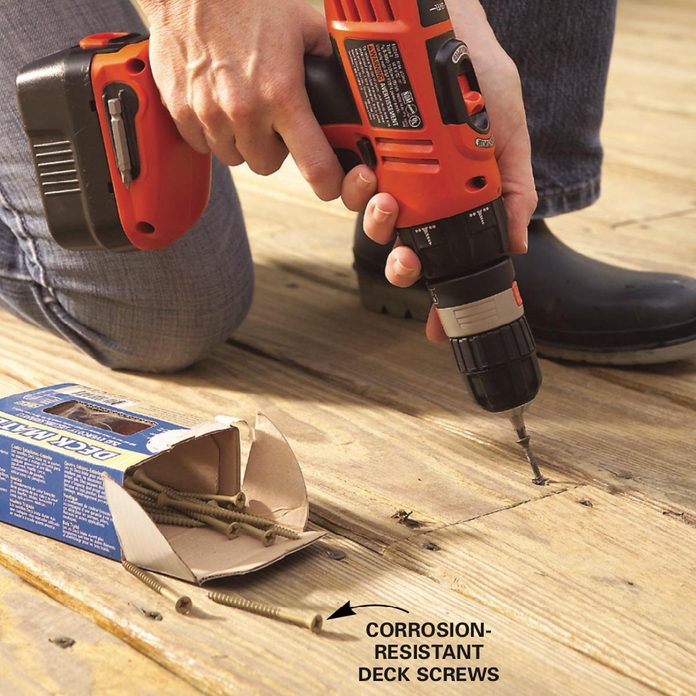
Sink any raised nails and screws. Replace loose and missing fasteners with screws at least 1/2 in. longer than the original. With the deck clean, it's like shooting fish in a barrel to spot whatsoever areas that need additional maintenance. Drive any nail heads that are popping up until they're flush with the deck boards. Look for missing or loose screws, and supercede them with corrosion-resistant screws that are slightly longer than the original (Photo 5). Replace missing nails with corrosion-resistant "trim head " screws, which are screws that accept a small caput and resemble a big stop boom.
If lag screws or bolts are loose in the ledger board, rails or posts, tighten them. Inspect the flashing betwixt your deck and house to ensure information technology's still firmly in place.
Step six
Attack stubborn stains
Scrub stubborn stains

Remove mold, mildew or algae using not-chlorine bleach. Scrub the expanse with a nylon brush, and then rinse with water. For tougher stains, echo the process with a TSP substitute.
Step vii
Remove fastener stains
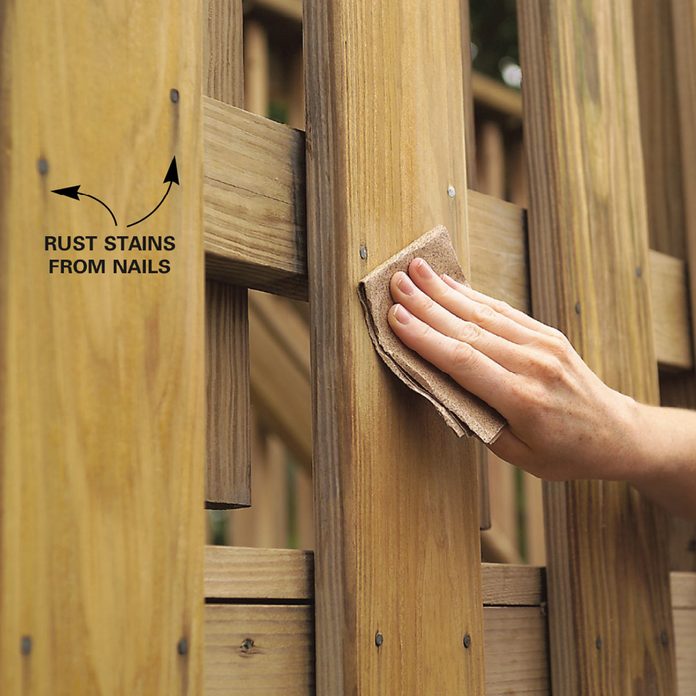
Bulldoze the heads of stain-causing fasteners beneath the forest surface. Then sand out the stains using 80-dust sandpaper. As well sand rough or splintered areas.
Although the sodium hydroxide in the deck cleaner volition remove about stains and mold, particularly stubborn ones crave extra attending.
Utilize a not-chlorine laundry bleach to remove the stain. (This works especially well if the stain is from mold, mildew or algae.) Use it to the affected area, and so scrub with a nylon brush. Rinse the surface area with water.
For tougher stains, utilise trisodium phosphate substitute. Mix the TSP substitute with water and utilise information technology to the stain. Let it sit for a minute or 2, then scrub with a nylon castor and rinse with water (Photo vi).
To remove deep stains that don't come out with TSP substitute, let the deck dry. These "bleed" stains are often acquired past fasteners. Sand the stains out, using lxxx-grit sandpaper and concentrating only on the affected areas. Some bleeds may be likewise deep to sand out. Rough or splintered areas may also need sanding. Spot-sand working in the management of the wood grain until the surface is shine (Photograph seven).
Wear a dust mask, and sand only if the stain bothers you. You don't have to get every stain out. After all, imperfections are part of an outdoor deck.
Step 8
Employ the finish—finally!
Stain the railing first
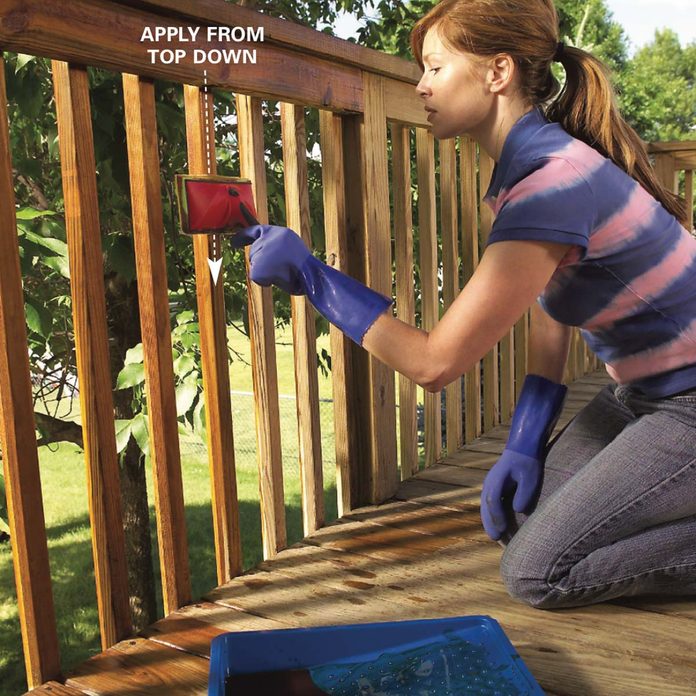
Apply stain to the top rail, then the balusters and the posts. Work from the summit down. Stain one section at a fourth dimension, using a foam applicator pad. Brush out drips every bit you work.
Step 9
Use an extension pole on the decking

Stain the deck boards using a foam applicator pad with an extension handle. Stain the full length of two or three boards at a time, working with the grain.
Step 10
Spray bottle applicator

Spray on the terminate in difficult-to-reach areas or surfaces that are hard to embrace with a paintbrush. Employ a broad spray to avoid streaks. Piece of work stain into crevices and narrow areas between balusters and posts with a paintbrush. The deck will demand a minimum of 48 hours to dry afterwards the cleaning. If information technology rains, await two more days for the wood to dry. Avoid staining in high heat, high humidity and in direct sunlight. Perfect atmospheric condition are an overcast day with the temperature in the 70s and no possibility of rain.
Start by staining the superlative runway and working down the balusters and posts (Photo viii). Run the applicator pad down the length of the forest, applying the stain in a steady, compatible manner. Don't go dorsum over areas that are already stained. Unlike paint, stain gets darker with each coat.
If stain drips onto the deck, smoothen it with the applicator pad to avoid spotting. One time the railings are complete, stain the deck boards. Load the pad with plenty of stain, notwithstanding not so much that it drips. Offset by advisedly "cutting in" stain along the house. If stain drips onto the siding, promptly wipe information technology off using a clean cloth and mineral spirits or pigment thinner.
Attach a broom handle to the applicator pad. Glide the pad along the length of the deck boards, staining with the grain (Photo nine). Cease only at the stop of a lath. Otherwise, the overlap where you stopped and started could be noticeable.
In one case the deck is finished, apply stain to the stair treads, working your fashion down the stairs.
Finally, utilize a paintbrush or spray bottle to piece of work stain into tight areas that the applicator pad couldn't accomplish, such as lattice and crevices between balusters and the rim joist (Photo 10).
Let the stain to dry at least 48 hours earlier walking on it. Feel the deck to make sure the stain is completely dry. Also, cheque the bottom of your shoes before walking back into the house.
Footstep 11
Pressure Washer Prophylactic

To utilize the pressure washer:
- Wear appropriate safe gear and clothes. Rubber boots and gloves will protect your hands and anxiety. Prophylactic goggles will keep the chemicals from splashing into your eyes, and a disposable respirator or grit mask will filter fumes.
- Keep the exhaust from the pressure level washer at to the lowest degree 3 ft. away from any objects, including your house.
- Practise spraying the h2o until you find an appropriate ability setting.
- Never point the wand at anything you don't want to spray.
- Cover electrical outlets.
Choosing the Best Stain
You have two basic deck stain choices: oil-based and water-based. Oil stains are easier to apply, penetrate the wood grain and require less work when you reapply them. However, they merely final two to 4 years.
Water-based (latex) stains last four to six years, but they'll eventually peel and crave more prep work before recoating. Opaque latex stains mostly terminal longer than semitransparent versions. When possible, test the stain on an inconspicuous section of the decking. Nosotros used a cedar colour that worked well since the wood was pressure treated and somewhat nighttime in color. For a darker color, a redwood-colored stain is bachelor, while a honey color is an choice for a lighter, natural woods expect.
Be careful not to choose a light color stain if your deck was previously covered with a nighttime stain or is pressure treated (green). The light stain volition not cover the dark woods or darker stain, and it will plow gray within a few weeks. If yous want a natural grayness or silver deck, use a clear finish. It will protect the deck from mildew and algae, simply not from the sun, allowing the deck to start graying in a calendar month or two.
The following companies offer a full line of products for cleaning and finishing decks, including strippers, brighteners and stains. The products are widely available at home centers, hardware stores and paint stores. Each company's Web site features a shop locator to discover the company's products.
Behr: behr.com
Cabot: cabotstain.com
Flood: flood.com
Wolman: wolman.com
Originally Published: July 12, 2021
Source: https://www.familyhandyman.com/project/deck-rescue-renew-your-deck/
Posted by: gonzalezplarecturs.blogspot.com


0 Response to "What Psi Do You Use To Clean A Wood Deck"
Post a Comment